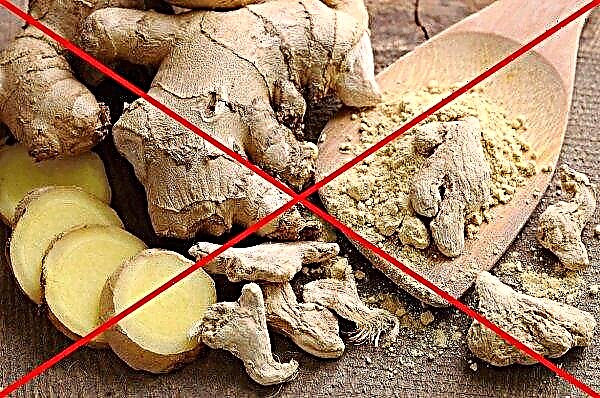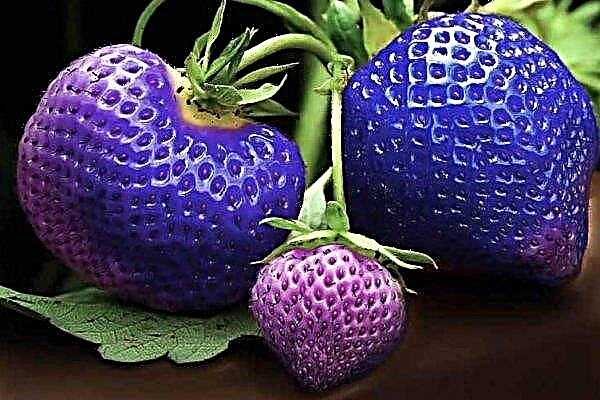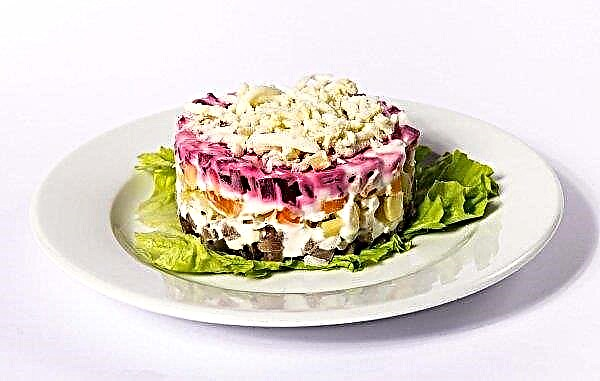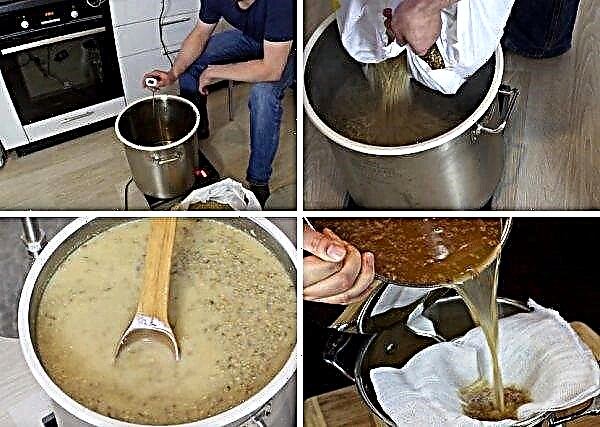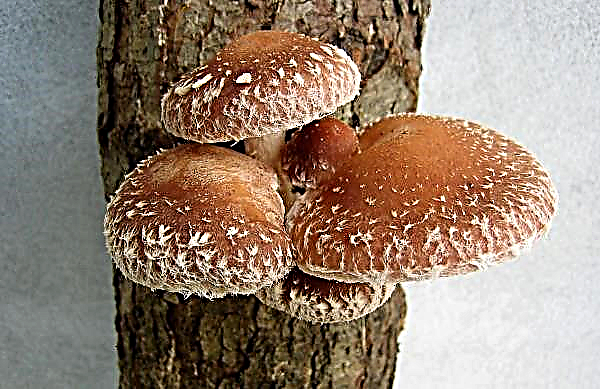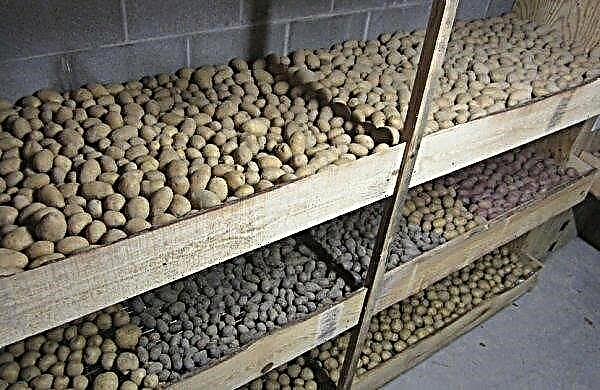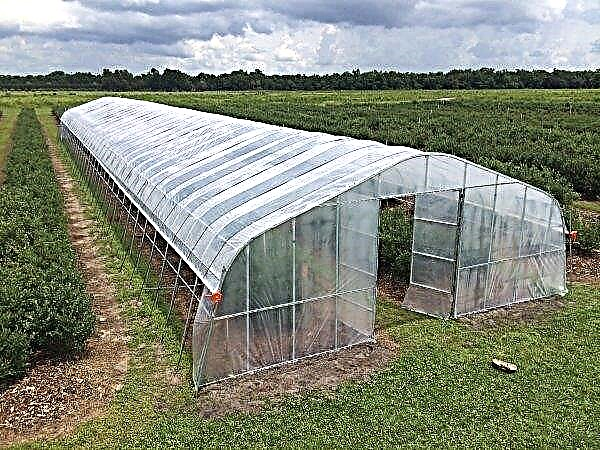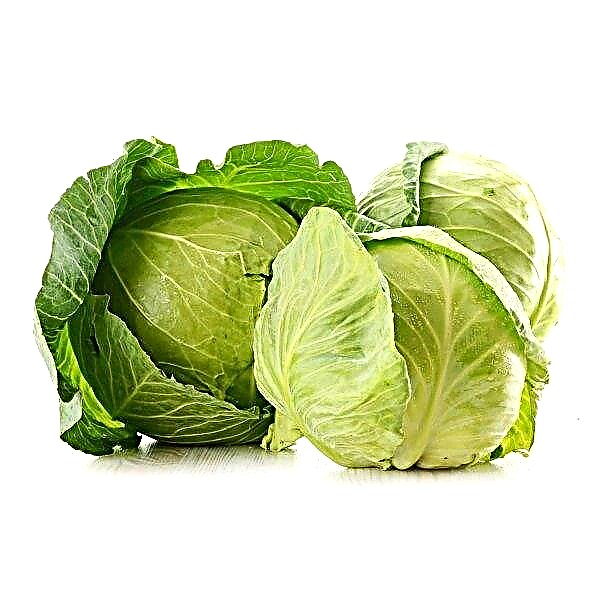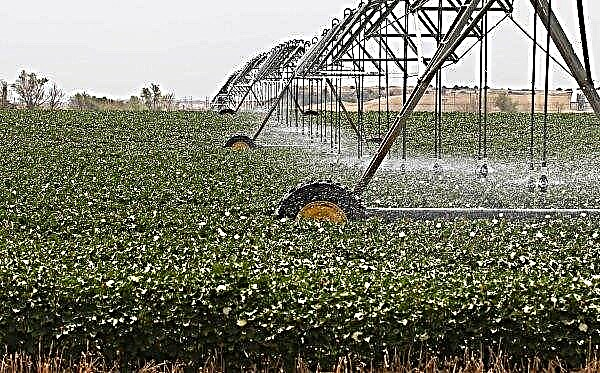Chicken meat is a product with high nutritional value and dietary properties. That is why many people involved in breeding chickens give the palm to meat breeds. What kind of breeds are considered meat and how to properly contain them, let's talk about this in our material.
Distinctive features of meat breeds of chickens
The name "meat breed" speaks for itself: these are chickens, the meat productivity of which is very high.
They are characterized by such features:
- Large body weight: for roosters - up to 5.5 kg, for chickens - up to 4.5 kg.
- The body is dense, well developed, with a large amount of muscle mass, located parallel to the ground.
- The plumage is fluffy.
- The bones are massive.
- Legs are short, large.
- The crest is small.
- Head and neck are medium sized.
- The character is calm.
- There is a tendency to hatch eggs.
- Egg production at the level of 130-150 eggs per year.
- Late onset of egg production (not earlier than 7 months).
- They tolerate winter well.
- Undemanding to the conditions of detention.
- Chickens quickly gain weight.
Description and characteristics of breeds of chicken meat
The most popular representatives of meat breeds and crosses of chickens are:
- Cornish
- grouse gopher;
- faverol;
- mini-meat;
- cobb-500;
- cobb-700;
- Ross-308;
- Ross-708;
- cochinchins;
- Mechelen cuckoo;
- color broilers;
- Arbor Aykres.

Cornish
The Cornish breed was received by English breeders from Cornwall on the basis of fighting breeds, which left an imprint on the character of the bird.
Characteristic of the breed:
- Plumage of white, red, dark or tan.
- The shoulders and chest are well developed.
- Head with well-developed superciliary arches, slightly sunken eyes, round nape.
- Small earrings, comb-shaped pod.
- The legs are muscular.
- The tail is short.
- Egg production - 110–130 eggs weighing 58–60 g with a light brown shell.
- Meat productivity: hens - 3–3.5 kg, roosters - 4–4.5 kg.
Groupe
Distinctive features of the breed:
Find out more

- The plumage color resembles a partridge - a reddish-brown color with a dark border.
- The tail is magnificent.
- The body is muscular.
- Wings are large, rounded in shape.
- Birds hold majestically, royally.
- The scallop is massive, in the form of a pod, the outlines are fuzzy.
- The beak is large, strong.
- The legs are muscular, plumage grows on the legs.
- Egg production starts from 9 months, up to 120 eggs per year, an egg weighs no more than 60 g, a beige shell. It does not decrease in winter.
- The meat productivity is good: the weight of chickens is up to 3.5 kg, roosters - up to 4.5 kg. The meat is stiff, but tasty.
Did you know? Partridge Brahma is one of the varieties of the Brahma breed, which was bred in 1840 in China.
Faverol
Faverole breed was named after the French province, where it was bred on the basis of several others.
Characteristic features of meat breed:
- The color of plumage is salmon, white, black, blue, striped, ermine, different for roosters and chickens. Roosters have a luxurious white mane, black on the neck and chest, and a black belly and tail.
- The body is elongated, muscular.
- The neck is shortened, powerful.
- The beard is big and fluffy, the catkins are small.
- The comb is serrated, in the form of a leaf, medium-sized.
- Plumage on the tail of medium length, magnificent.
- Paws are short, covered with feathers, have 5 fingers.
- The posture is magnificent.
- Egg production is about 120 eggs per year weighing 55–65 g with a peach-colored shell. Ripen early.
- Meat productivity is average: hens weigh up to 3 kg, roosters - up to 4 kg, the taste of meat is delicate, the percentage of meat yield is high.
Mini meat chickens
Scientists from the Zagorsk Scientific Research Technological Institute of Poultry in the Moscow Region bred a breed of mini-meat chickens with the following characteristics:
- Feathers are painted white, red with black or straw color, there are other color options, grow densely.
- Small size, so you can increase the population density.
- Short paws.
- Comb in the shape of a leaf, medium size.
- Gain weight quickly.
- Eat little.
- Egg production - up to 180 eggs in a brown shell per year with a mass of 1 egg up to 60 g.
- Chickens weigh about 2.5 kg, roosters - about 3 kg. The taste of meat is excellent.

Important! Do not walk these birds in wet weather - dirt stuck to the stomach due to short legs can cause health problems. For the same reason, it is important that the litter in the chicken coop is dry.
Cobb-500
The work of breeders to increase meat productivity has led to the creation of the Cobb-500 cross - broilers based on crossbreeding of Plymutrok roosters and white Cornish hens. In addition to these, other breeds can be used.
Cobb-500 is profitable to breed in large farms with an impressive annual sales turnover; home breeding does not make sense.

Distinctive features:
- Feathers are white.
- Well developed chest and shoulders.
- Powerful legs, high paws.
- Small scallop and catkins of bright red color.
- Yellow skin color.
- Thin bones.
- Fast weight gain, you can score in 35–45 days from hatching.
- They do not pass on their characteristics to offspring; therefore, they are not used to incubate the parent flock and lay eggs for incubation.
- Low egg production - up to 60 eggs per year, although they are not kept before it begins.
- The instinct of incubation is low.
- It is possible to feed with cheap feeds with low nutritional value, this is reflected poorly in productivity.
- All birds are the same.
- It is unprofitable to keep more than 80 days, as the rate of increase in muscle mass decreases.
- No need to walk.
- The meat is tender, a 45-day-old carcass weighs 2.5 kg.
Important! Cobb-500 is the best cross in terms of profitability of breeding, and Cobb-700 is the best cross in terms of meat yield.
Cobb 700
Cross Cobb-700 - An improved version of the Cobb-500, has the following characteristics:
- Snow-white plumage.
- Bright red comb, catkins, face.
- Strongly developed sternum muscles, predominance over other parts of the body.
- The skin is yellow.
- Can be kept without walking.
- Egg production begins at 6 months, the weight of the eggs reaches 70 g with an amount of about 100 pcs. in year.
- The instinct of incubation is not developed.
- Meat productivity: 45-day-old chickens weigh more than 4 kg.
Ross-308
Cross broilers Ross-308 hails from the UK, its characteristic features are:
- Feathers are white.
- The trunk is oblong, the muscles of the sternum and legs are well developed, the chest is wide.
- The skin is thin, light flesh-colored.
- Paws are painted yellow, strong, tall, widely spaced.
- The head is small, the crest and earrings are bright red, small.
- The instinct of incubation is not developed.
- Signs of parents are not transmitted to chickens.
- The maximum possible weight is 5.5 kg, ready for slaughter at the age of one month with a weight of 1.5 kg.
- The meat yield is about 70%, of which 30% is breast.
- Egg production begins at 6 months, but before this age the birds are already slaughtered. Large eggs - 65 g, quantity - 185 pcs. in year.

Ross-708
Further research led to the creation of cross-Ross-708, the characteristics of which are:
- White color feathers.
- The red color of the comb and beard, they do not stand out in size.
- Large muscles of the sternum, well-developed legs.
- The skin is flesh-colored.
- Paws are pale yellow, tall.
- The highest weight gain rate among crosses is 58 g per day; a 40-day-old chicken weighs more than 3 kg. The meat is tender, tasty.
- Egg production rates are lower than Ross-308.
Did you know? The substance choline, which is contained in chicken eggs, is necessary for memory and proper cell division of our body.
Kokhinkhiny
The Kokhinhin breed from China is considered one of the largest, it can be described as follows:
- Growth about 75 cm, although there is a dwarf species of birds.
- Spherical body, raised upward from the side of the tail.
- The back and head are small, on the head are a modest-sized catkins, a crest in the shape of a leaf, the teeth of which are clearly distinguishable.
- Powerful wide neck.
- Neat round tail.
- Fluffy plumage, on short legs fluffy “panties”.
- During molting, chickens grow naked for a long time.
- The color of the feathers is straw, white, blue, yellow, black, partridge.
- The character is calm.
- Can hatch chickens.
- They do not know how to fly.
- Chickens carry up to 110 eggs in a brown shell per year weighing about 45 g each. An increase in egg production is observed in winter.
- Meat productivity: chickens - up to 4 kg, roosters - up to 5 kg.

Did you know? Since chickens and hatching eggs are not cheap, the breed is often bred as a decorative, and not for the purpose of selling for meat.
Mechelen cuckoo
The Belgian breed of raspberries, or Mechelen cuckoo, is characterized as follows:
- Feathers are painted in strips of black and white (cuckoo color) or black, white, blue.
- Powerful paws are covered with feathers on the outside.
- The comb is in the form of a leaf, less often in the form of a pod, an earring of oblong shape.
- The pectoral muscles are well developed, protruding forward.

- The wings are small; birds cannot fly.
- The tail is short.
- Egg production begins at 6 months, they carry up to 160 eggs per year weighing up to 65 g each.
- Large birds: rooster weight - up to 5 kg, chicken - up to 4 kg. The meat is tender, with a special taste, the fibers are thin.
Did you know? Popular dishes of Belgian national cuisine in Mechelen - baked chicken Mechelen cuckoo with vegetables and mushrooms in a creamy sauce and chicken breast «mechelse cuckoo»washed down with Belgian beer.
Color broilers
Colored broilers are chicken of meat and egg direction, they include the following breeds:
- redbro;
- master gris;
- Hungarian giants;
- Cornish
- foxy cheek;
- naked nek (golosheynoy broiler);
- Sasso XL-551.

Distinctive features of color broilers:
- The body is oblong, the back is even, the chest is protruding forward, the head is small.
- Strong bones, well developed muscles.
- High rate of weight gain.
- Bright skin.
- In addition to the Hungarian giants, all birds of small stature.
- Bright color of plumage.
- Well adapted to any conditions, suitable for beginner poultry farmers.
- High meat productivity: a one-month-old young weighs 1 kg, a two-month-old - up to 2.5 kg. The maximum weight of chickens is up to 4-5 kg, roosters - up to 7 kg.
- Good instinct for hatching.
- Egg production reaches 250-300 eggs per year, 60 g each.
Did you know? Double yolk eggs can only be laid by young hens, but their twin chickens will not be able to hatch.
Arbor Aykres
Chickens cross arbor Aykres are considered the most economically viable, they are characterized by:
- White color plumage.
- Short powerful legs.
- The body is rounded in front and narrowed in the tail.
- Broad chest and back.
- Short, slightly curved neck.
- Small head.
- Yellow skin color.
- The character is calm, slightly shy.
- The ability to quickly gain weight on feeds that do not contain growth stimulants.

- The maximum weight of a rooster is up to 6 kg, chicken - up to 5 kg.
- The eggs begin to lay no earlier than 7 months of age, the number of eggs reaches 120 pcs. per year, mass - about 58 g, white shell.
- Maternal instinct is not developed.
Did you know? In 2002, a geneticist from Israel Avigdor Cohaner first introduced the breed of chickens without down and feathers, but only in 2011 this breed was fixed.
Basic rules for breeding and keeping
In order to breed meat chickens, it is necessary to observe such requirements for their maintenance:
- Purity - the chicken coop should be cleaned and disinfected regularly.
- Dry litter that absorbs moisture well - You can use straw or sawdust, which should be changed regularly.
- Availability of light source - if the goal is to get meat, 1 window will be enough, if you want to get eggs as well, you need a dim light.
- Temperature - so that the birds do not stray into a heap, trying to keep warm, and gain weight well, you need to monitor the thermometer: it should not show below +25 ° C.
- Balanced diet - the meat feed of poultry should contain a sufficient amount of protein, vitamins and minerals, otherwise you won’t get a decent weight gain. It is also necessary to observe the norms for the amount of feed per day.
- Resettlement density - if you settle more than 15 chickens per 1 square. m, they will be worse gain weight.
- The ability to clean feathers - For this, chickens need ash or sand.
- Separate content of different breeds - in order to maintain breed characteristics, it is not necessary to mix breeds, cross-breeds and in-breed colors.
- Water - chickens need clean fresh water from drinking bowls, which should be cleaned regularly.
- Fresh air - there should be ventilation openings in the chicken coop, it needs to be ventilated.
- Low perches and nests - those who breed feathered meat breeds at home without cages should remember that these feathered big and heavy ones cannot fly, therefore they will not be able to climb high.
- Walking - for the birds to gain weight well, they need to move as little as possible, therefore, a cell content without walking is recommended.

Thus, meat breeds of chickens are characterized by simplicity of maintenance and great economic benefits. When they are bred, you can get not only a large amount of delicious dietary meat, but also eggs, which are larger than that of chicken egg breeds.
And although these birds do not require special conditions for keeping, do not forget that the quality of meat and its quantity depend on compliance with elementary requirements.



